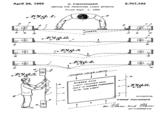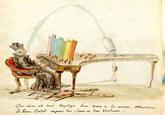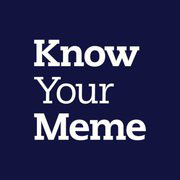Visual Music
Submission 3,832
Overview
Visual Music refers to the performance, construction and/or presentation of music through the use of visual imagery. It is the translation of the aural arts into visual arts.
History
In 1704, Sir Isaac Newtown debuted an idea that the prismatic spectrum of seven colors related to the seven musical tones of the diatonic scale.[3] He devised a wheel to describe his theory (shown below, left) in his 1704 treaties "Optiks."
Roughly 20 years later, French mathematician Louis Bertran Castel attempted to put Newton's theories into practice. Castel's "lavecin pour les yeux" or "harpsichord for the eyes" was an instrument outfitted with sixty multi-hued lanters that illuminated when notes were played (shown below, right). Like a keyboard or synthesizer, different keys produced different colors. As Castel wrote, "The pressing of the keys would bring out the colours with their combinations and their chords; in one word, with all their harmony, which would correspond exactly to that of any kind of music."


Art critic Roger Fry coined the term "visual music" in 1912. While many claim that Fry used the expression to describe influential visual musician Wassily Kandinsky,[1] other contend that the first usage of the term came in reference to the later work of Picasso. In the preface to the catalogue for post-impressionist exhibit he organized at the Grafton Galleries,[2] he wrote:
"The logical extreme of such a method would undoubtedly be the attempt to give up all resemblance to natural form, and to create a purely abstract language of form -- a visual music; and the later works of Picasso show this clearly enough. They may or may not be successful in their attempt.”
Throughout the 1910s, futurists Bruno Corra and Arnaldo Ginna produced films that experimented with color music. Mary Hallock-Greenwalt, additionally, made films that were visualization of musical form.[4]
In May 1919, artist Thomas Wilfred enginnered the Clavilux, a device that culd be used for the performance of "lumia," Wilfred's term for light art or color music (examples below). He built smaller versions of this type of instrument meant for home installation.
In the late 1940s, Oskar Fischinger, a leading artist in abstract musical animation and former Disney animator, developed the Lumigraph. Designed to be a commercial product, the Lumigraph worked by pressing a rubber screen, which would protrude into a narrow beam of light. While the device was silent, the it would be played with accompanying music.[6]

In 1995, the Animusic company launched to specialize in the 3D visualization of MIDI-based music.[7]
Highlights
In May 2002, Jarmo Niinisalo discovered two faces in the sound waves of the 1999 Aphex Twin single "Windowlicker." According to Wired,[9] the faces (shown below) "can be reproduced with a sample of the song and some spectrographic software, which displays the different frequencies of the song as a graph against time. The image doesn't appear in an MP3 file of the song; the compression algorithm destroys the image."

On June 22nd, 2017, Google celebrated Oskar Fischinger's 117th with a Google doodle that doubled as a visual music sequencer.[8] The software allows users to press different shapes, which corresponded to different tones and notes.
Related Memes
MIDI Animations
MIDI Animations (MIDIアニメ) are user-created videos that illustrate MIDI compositions visually through a careful arrangement of color-coded musical blocks. Using a MIDI software called the Music Animation Machine MIDI Player, or simply MAM, each artist can create his/her own “visual representation” of any MIDI file, with each colored block corresponding to every musical note registered in the song. MIDI animations first became popular in October 2007 on the Japanese video-sharing website Nico Nico Douga.
Mario Paint Songs
Mario Paint Songs are musical compositions created by individuals using Mario Music Composer, an audio-editing tool included in the popular SNES video game Mario Paint. For more information about the game itself, see the section below. Today, popular video-sharing sites like YouTube and Nico Nico Douga feature thousands of Mario Paint songs made with third-party softwares like Mario Paint Composer and Mario Sequencer.
Automatic Mario
Automatic Mario (自動マリオ) is a subgenre of remix videos that emulate popular songs and soundtracks through gameplay footage of customized level stages in Super Mario World. Mostly created by fans using Super Mario ROM editors, musical compositions in Auto-Mario videos are carefully prearranged by the architectural design of each level and thus rarely requires any input from the player. However, there are other types of Super Mario MOD levels that can be played manually or semi-manually with musical accompaniments.
Search Interest
External References
[1] The Telegraph – The man who heard his paintbox hiss
[2] joostrekveld – the origin of the term visual music
[3] Motherboard – Behold the Ocular Harpsichord, the Laser Light Show of the 18th Century
[4] AWN – The Dream of Color Music, And Machines That Made it Possible
[5] Lumia-Wilfred – Introduction
[6] Wikipedia – Oskar Fischinger
[8] Google – Oskcar Fischinger Sequencer
[9] Wired – Hey, Who's That Face in My Song
Share Pin







